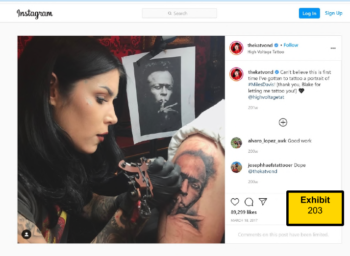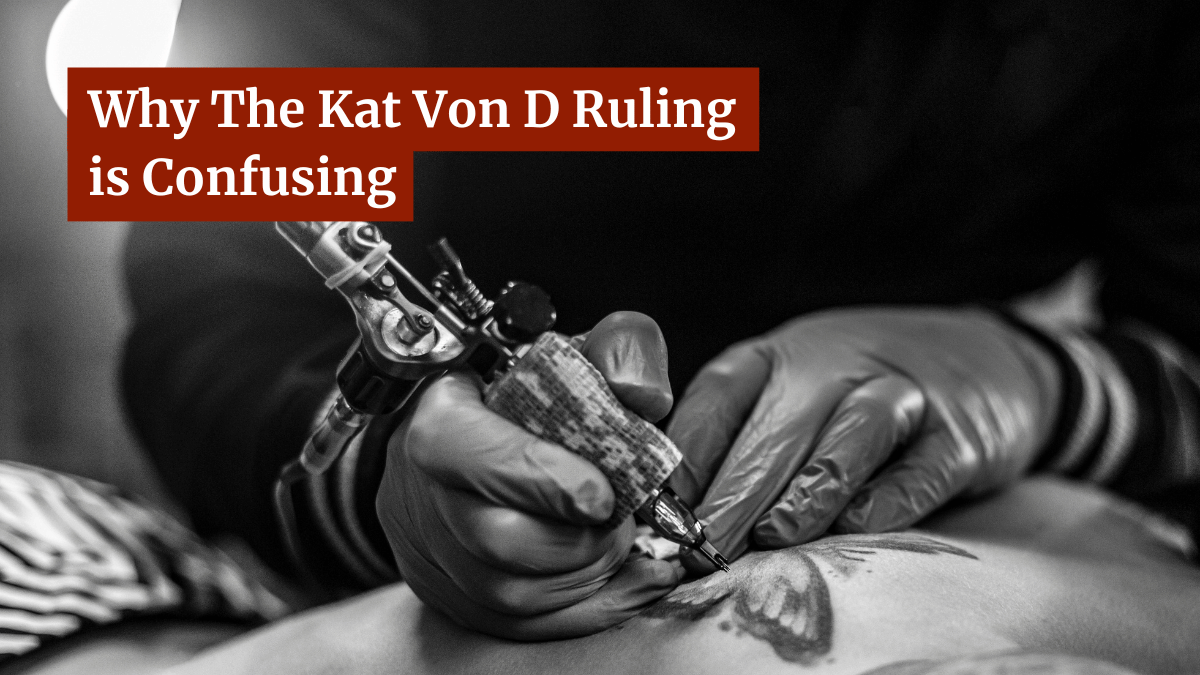Why The Kat Von D Ruling is Confusing

Last week, celebrity tattoo artist Kat Von D won a jury verdict in her case against photographer Jeff Sedlik.
Sedlik had sued Von D alleging copyright infringement of a photograph he took of musician Miles Davis when creating a tattoo that she put on a friend’s arm. He also alleged infringement in social media posts that featured the tattoo and promoted her business.
The heavily anticipated ruling had been framed as one of the first major fair use cases to be heard following the recent Supreme Court decision in the Andy Warhol case. Copyright watchers, me included, were eager to see just how the jury would apply the new guidance on fair use to this case.
However, that is not what any of us got.
Though the jury did rule that social media posts were protectable under fair use, the question of the tattoo itself was decided by the jury ruling that the work was not “substantially similar” to the original work, meaning that it was not an infringing work at all.
While a significant win for Von D, the verdict has left many copyright watchers scratching their heads. Though some elements of the photograph are not protectable, most notably Davis’ likeness, Von D openly admitted to copying the photograph and even shared images of her using the image as a reference for drawing the tattoo. Other protectable elements, such as the pose of Davis’ hand, his facial expression and so forth were directly copied.
Since there have been no interviews with the jurors, it is impossible to know how or why they reached the decision they did. Aaron Moss at Copyright Lately said, “Of course it is also possible that once the jurors decided to rule in Von D’s favor, they just wanted to arrive at that decision using the fewest number of steps possible. We have seen that before.”
However, regardless of the basis for the verdict, a lawyer for Sedlik had previously protested the issue of substantial similarity being put before the jury and has vowed to appeal the decision on those (and likely other) grounds.
Though there are a great deal of challenges in appealing a jury verdict, many feel that such an appeal has an unusually strong chance given both allegations of a confusing juror form and the jury disobeying the judge’s instructions to rule on the social media posts.
But, even with the prospect of an appeal, this case took an unexpected turn, and it is worth examining both why it likely did and what is next.
An Unexpected Decision
When the decision went to the jury, most felt that the real issue was going to center around questions of fair use. This included Moss, who said, “The threshold issue in the trial is substantial similarity—whether Kat Von D’s tattoo copies protectible elements of expression from the original Miles Davis photo. That said, expect most of the action to center on the fair use defense.”
Simply put, the fact that the tattoo and the photo were substantially similar did not seem to be up for much debate. Though there were differences between the two, Von D openly admitted to copying the photo and that included protectable elements, including the pose of hand and the general composition of the image.
In short, though the jury was directed to address the issue, it seemed to most to not be very controversial. Instead, that is exactly what the jury ruled on.
However, it has made even more confusing by the decision to rule on the social media posts and find that those are a fair use. Typically, if the original tattoo is non-infringing because it is not substantially similar, then any subsequent uses would not be infringing on the same grounds. To rule that those were a fair use indicates that, without the fair use defense, they would be infringing.
Note and Correction: David Newhoff, in an email, pointed out that the social media posts also included the image itself, in addition to the tattoo. This means that the jurors were weighing in on the use of the photo as part of the social media posts, not just the tattoo. You can see this in the image above. In that context, the fair use decision does make more sense.
In that regard, the ruling is self-contradictory. This is something that law professor Bruce Boyden noticed when speaking with Kyle Jahner at Bloomberg Law, saying that it is, “a little bit legally inconsistent.”
As such, it seems like this fight has only begun, with the appeals court having some tough questions to parse. While, normally, it is exceedingly difficult to motivate an appeals court to overturn a jury verdict, there seems to be enough issues here to at least make the court weigh the case carefully.
Not a Sweeping Victory
Von D, for her part, has been quick to tout this as a major legal victory for tattoo artists. However, that is not really the case.
Even if we ignore the likely appeal and the issues that it raises, the case only really applies to this one image. To quote David Newhoff at Illusion of More, “Just because one alleged copy is held to be non-infringing on the basis that it is not substantially similar to the plaintiff’s work, this predicts little to nothing about the next potential claim of infringement in the tattoo world, or for artists in any other media.”
Since the jury found that the tattoo was not significantly similar, it is not a decision that other tattoo artists can easily turn to. It only applies to this photo and this tattoo.
In that regard, a sweeping fair use decision would have been much better for other tattoo artists. If the jury had found that, broadly, creating a tattoo based on an existing copyright-protected work is a fair use, other artists could have cited that case as precedent. However, as is, future tattoo artist defendants will have to start from square one.
In short, if the verdict does hold, it is not likely to help other tattoo artists as a different case would require a reevaluation of these issues, likely prompting a different decision. So, while the verdict is a victory for Von D, it is not nearly as much of one for other artists in a similar position.
Bottom Line
In many ways, this verdict is the worst of all worlds. It is a major defeat for Sedlik and those who support him. However, supporters of Von D do not get the sweeping verdict that they were hoping for either. No one, other than Von D, really wins here.
That said, this will be a case to watch on appeal. Between allegations substantial similarity should not have been put the jury, questions over the clarity of the juror form and the contradictory nature of the verdict itself, there is a lot for the Ninth Circuit Court of Appeals to examine.
Though, under normal circumstances, it is incredibly difficult to get a jury verdict overturned, these are not normal circumstances.
So, this case will be worth keeping an eye on moving forward. In the end, it could still end up being the crucial fair use decision many thought it would be, it might just take a longer route to get there.
Want to Reuse or Republish this Content?
If you want to feature this article in your site, classroom or elsewhere, just let us know! We usually grant permission within 24 hours.
